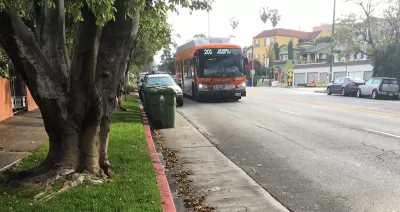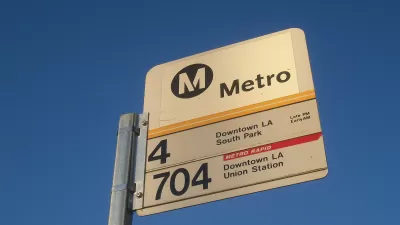Major changes are coming to the Metro bus system in the nation's second largest city. After three years of planning and public feedback, the Metro board has approved the NextGen bus plan.

The Los Angeles County Metropolitan Transportation Authority (Metro) Board of Directors recently approved the NextGen bus plan after three years of planning and a high profile outreach and public engagement campaign, according to an article by Steve Hymon for Metro's The Source.
Metro planning staff released a draft of the plan in January 2020, but the plan largely vanished from the public eye as the pandemic gutted transit ridership in the city. Now the plan for the nation's second busiest bus system will begin to implement service changes in December 2020, with a second and third round of changes coming in June 2021 and December 2021, respectively.
"Under the new plan — to be implemented in stages, beginning in December (more on this below) — buses will arrive every five to 10 minutes for 83 percent of current riders compared to around 48 percent today," according to Hymon.
One of the key changes of the NextGen plan will be to combine most rapid and local bus routes. "These new lines will stop fewer times than a local bus but a few more than a rapid. Transit signal priority that has been a key part of rapid service will also now work these new lines. The end result will be a faster door-to-door trip for all riders, whether they currently take Metro Local or Rapid routes," according to Hymon.
A significant obstacle standing in the way of full implementation of the NextGen plan includes ridership and fare revenues decimated by the pandemic. Metro staff are expected to deliver a plan for increasing service while dealing with declining system revenues later this year.
FULL STORY: NextGen Plan to improve Metro Bus system is approved by agency’s Board of Directors

Study: Maui’s Plan to Convert Vacation Rentals to Long-Term Housing Could Cause Nearly $1 Billion Economic Loss
The plan would reduce visitor accommodation by 25,% resulting in 1,900 jobs lost.

North Texas Transit Leaders Tout Benefits of TOD for Growing Region
At a summit focused on transit-oriented development, policymakers discussed how North Texas’ expanded light rail system can serve as a tool for economic growth.

Why Should We Subsidize Public Transportation?
Many public transit agencies face financial stress due to rising costs, declining fare revenue, and declining subsidies. Transit advocates must provide a strong business case for increasing public transit funding.

A Visual Celebration of Manhattan’s Chinatown Elder Community, Through Food
Lanterns, cafeteria trays, and community connection take center stage in this stunning photo essay.

How to Make US Trains Faster
Changes to boarding platforms and a switch to electric trains could improve U.S. passenger rail service without the added cost of high-speed rail.

Columbia’s Revitalized ‘Loop’ Is a Hub for Local Entrepreneurs
A focus on small businesses is helping a commercial corridor in Columbia, Missouri thrive.
Urban Design for Planners 1: Software Tools
This six-course series explores essential urban design concepts using open source software and equips planners with the tools they need to participate fully in the urban design process.
Planning for Universal Design
Learn the tools for implementing Universal Design in planning regulations.
City of Santa Clarita
Ascent Environmental
Institute for Housing and Urban Development Studies (IHS)
City of Grandview
Harvard GSD Executive Education
Toledo-Lucas County Plan Commissions
Salt Lake City
NYU Wagner Graduate School of Public Service





























